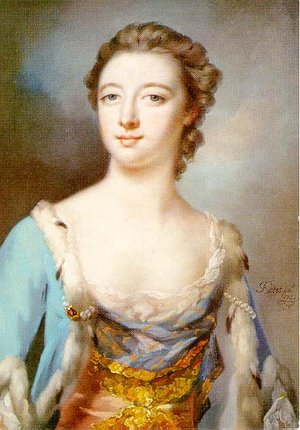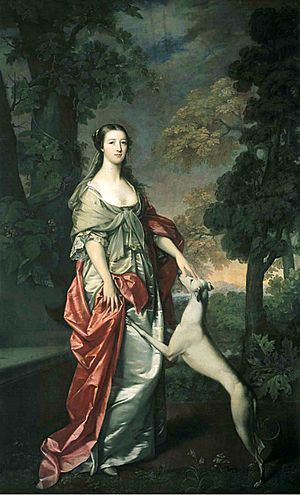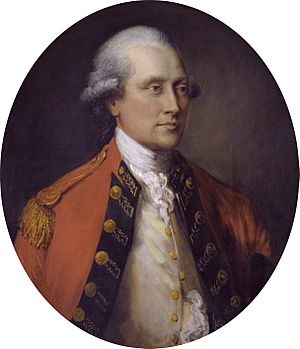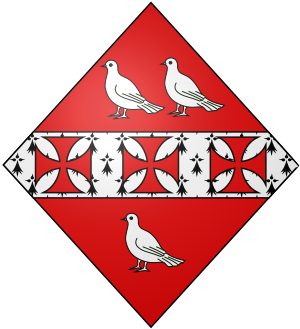Elizabeth Hamilton, 1st Baroness Hamilton of Hameldon facts for kids
Quick facts for kids
The Duchess of Argyll
|
|
|---|---|

The 1st Baroness Hamilton of Hameldon
|
|
| Born | December 1733 Hemingford Grey, Huntingdonshire |
| Died | 20 December 1790 (aged 56–57) Argyll House, Argyll Street, Westminster |
| Buried | Kilmun, Argyllshire |
| Spouse(s) | James Hamilton, 6th Duke of Hamilton John Campbell, 5th Duke of Argyll |
| Issue | Elizabeth Smith-Stanley, Countess of Derby James Douglas-Hamilton, 7th Duke of Hamilton Douglas Douglas-Hamilton, 8th Duke of Hamilton Lady Augusta Campbell George John Campbell, Earl of Campbell George Campbell, 6th Duke of Argyll Lady Charlotte Campbell John Campbell, 7th Duke of Argyll |
| Father | John Gunning |
| Mother | Hon. Bridget Bourke |
Elizabeth Campbell, Duchess of Argyll, 1st Baroness Hamilton of Hameldon (born around December 1733 – died December 20, 1790) was a very famous and beautiful lady from Anglo-Irish background. She was also a lady-in-waiting to Queen Charlotte and a well-known host for important social events. Before she became the Duchess of Argyll, she was known as Elizabeth Hamilton, Duchess of Hamilton. Her maiden name was Gunning.
Contents
Early Life
Elizabeth Gunning was born in Hemingford Grey, Huntingdonshire, England. Her father was John Gunning from Castle Coote, County Roscommon, and her mother was Bridget Bourke. Bridget was the daughter of Theobald Bourke, 6th Viscount Mayo. Elizabeth had an older sister named Maria Gunning, who later became the Countess of Coventry.
In the early 1740s, Elizabeth's family moved back to Ireland. They lived in their country house in Roscommon and also had a rented house in Dublin. Some stories say that when Elizabeth and Maria grew up, their mother encouraged them to try acting. This was to help the family earn money, as they were not very rich.
In October 1748, a big party was held at Dublin Castle. Elizabeth and Maria did not have fancy dresses for the event. So, Thomas Sheridan, who managed a local theatre, gave them two costumes. They dressed up as Lady Macbeth and Juliet from famous plays. Wearing these costumes, they met the Earl of Harrington, who was a very important official in Ireland.
The Earl of Harrington was impressed by the sisters. By 1750, their mother, Bridget Gunning, had convinced him to give her some money regularly. She used this money to move herself and her daughters, Maria and Elizabeth, back to England. They attended many parties and balls, and everyone noticed how beautiful they were. Their fame quickly spread, even reaching London. On December 2, 1750, they were introduced at the King's Court in London. Their presentation was so famous that it was even written about in the London newspapers.
Many famous artists painted Elizabeth. These included Joshua Reynolds and Gavin Hamilton.
Marriages

In early 1752, Elizabeth met the young James Hamilton, 6th Duke of Hamilton (1724–1758). It is said that on Valentine's Day, February 14, at a party, the Duke decided he wanted to marry Elizabeth that very night. He called for a local priest to perform the wedding. However, the priest refused because they did not have a special license, public announcements, or a wedding ring.
They eventually got married that same night in a place called May Fair Chapel. This chapel did not require a special license for quick weddings. They used a ring from a bed-curtain for the ceremony. After this, Elizabeth became the Duchess of Hamilton.
A writer named Horace Walpole once wrote about the Duke and Duchess. He said they were very proud. They would walk into dinner before their guests and sit at the head of their table. They even ate from the same plate and would only drink to people who were at least an Earl.
The Duke of Hamilton sadly died on January 17, 1758, when he was only 33 years old. After his death, Elizabeth became engaged to Francis Egerton, 3rd Duke of Bridgewater. But this engagement was called off that same year for reasons we don't know.
On February 3, 1759, Elizabeth married again. Her second husband was John Campbell, Marquess of Lorne. He was the son and future heir of the Duke of Argyll.
From 1761 to 1784, Elizabeth worked as a Lady of the Bedchamber for Queen Charlotte. This meant she was a close attendant to the Queen. In 1770, her husband became the Duke of Argyll, and Elizabeth became known as the Duchess of Argyll. On May 20, 1776, King George III, who admired her for a long time, gave her a special title. He made her the Baroness Hamilton of Hameldon in her own right.
Children
Elizabeth had three children from her first marriage to the Duke of Hamilton:
- Lady Elizabeth Hamilton (born January 26, 1753 – died March 14, 1797), who married Edward Smith-Stanley, 12th Earl of Derby.
- James Hamilton, 7th Duke of Hamilton (born February 18, 1755 – died July 7, 1769).
- Douglas Hamilton, 8th Duke of Hamilton (born July 24, 1756 – died August 2, 1799).
Elizabeth had five children from her second marriage to the Duke of Argyll:
- Lady Augusta Campbell.
- George John Campbell, Earl of Campbell (1763–1764).
- George Campbell, 6th Duke of Argyll (1768–1839).
- Lady Charlotte Campbell (1775–1861), who married Colonel John Campbell first, and then Rev. Edward John Bury.
- John Campbell, 7th Duke of Argyll (1777–1847).
Later Life
Elizabeth passed away on December 20, 1790. She died at her home, Argyll House, in London. She was buried at Kilmun Parish Church in Kilmun, Argyllshire, Scotland.
Honours
As Baroness Hamilton of Hameldon, Elizabeth was given her own special grant of arms. This is like a unique symbol or design for her family. Her coat of arms included a red shield with a white band across the middle. On this band were three crosses. It also had three silver doves with golden crowns. These designs included parts of her own Gunning family's symbols.




